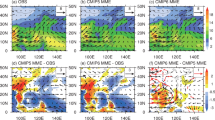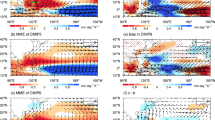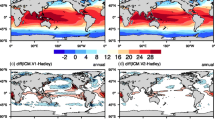Abstract
The subtropical North and South Pacific Meridional Modes (NPMM and SPMM) are well known precursors of El Niño-Southern Oscillation (ENSO). However, relationship between them is not constant. In the early 1980, the relationship experienced an interdecadal transition. Changes in this connection can be attributed mainly to the phase change of the Pacific decadal oscillation (PDO). During the positive phase of PDO, a shallower thermocline in the central Pacific is responsible for the stronger trade wind charging (TWC) mechanism, which leads to a stronger equatorial subsurface temperature evolution. This dynamic process strengthens the connection between NPMM and ENSO. Associated with the negative phase of PDO, a shallower thermocline over southeastern Pacific allows an enhanced wind-evaporation-SST (WES) feedback, strengthening the connection between SPMM and ENSO. Using 35 Coupled Model Intercomparison Project Phase 6 (CMIP6) models, we examined the NPMM/SPMM performance and its connection with ENSO in the historical runs. The great majority of CMIP6 models can well reproduce the pattern of NPMM and SPMM, but reveal discrepant ENSO and NPMM/SPMM relationship. The intermodal uncertainty for the connection of NPMM-ENSO is due to different TWC mechanism. A stronger TWC mechanism will enhance NPMM forcing. For SPMM, few models can simulate a good relationship with ENSO. The intermodel spread in the relationship of SPMM and ENSO owing to SST bias in the southeastern Pacific, as WES feedback is stronger when the southeastern Pacific is warmer.
Similar content being viewed by others
5 Data Availability Statement
The reanalysis data were downloaded from the Met Office Hadley Centre (HadISST; https://www.metoffice.gov.uk/hadobs/hadisst/index.html), NOAA Physical Sciences Laboratory (https://psl.noaa.gov/data/gridded/data.ncep.reanalysis.html), and the Asia-Pacific Data-Research Center (ORAS4, http://apdrc.soest.hawaii.edu/datadoc/ecmwf_oras4.php). The CMIP6 models are available online at https://esgfnode.llnl.gov/search/cmip6/.
References
Anderson B T. 2007. On the joint role of subtropical atmospheric variability and equatorial subsurface heat content anomalies in initiating the onset of ENSO events. Journal of Climate, 20(8): 1593–1599, https://doi.org/10.1175/JCLI4075.1.
Anderson B T, Perez R C. 2015. ENSO and non-ENSO induced charging and discharging of the equatorial Pacific. Climate Dynamics, 45(9): 2309–2327, https://doi.org/10.1007/s00382-015-2472-x.
Anderson B T, Perez R C, Karspeck A. 2013. Triggering of El Niño onset through trade wind-induced charging of the equatorial Pacific. Geophysical Research Letters, 40(6): 1212–1216, https://doi.org/10.1002/grl.50200.
Balmaseda M A, Mogensen K, Weaver A T. 2013. Evaluation of the ECMWF ocean reanalysis system ORAS4. Quarterly Journal of the Royal Meteorological Society, 139(674): 1132–1161, https://doi.org/10.1002/qj.2063.
Bretherton C S, Widmann M, Dymnikov V P et al. 1999. The effective number of spatial degrees of freedom of a time-varying field. Journal of climate, 12(7): 1990–2009, https://doi.org/10.1175/1520-0442(1999)012<1990:TENOSD>2.0.CO;2.
Capotondi A, Wittenberg A T, Newman M et al. 2015. Understanding ENSO diversity. Bulletin of the American Meteorological Society, 96(6): 921–938, https://doi.org/10.1175/BAMS-D-13-00117.1.
Chakravorty S, Perez R C, Anderson B T et al. 2020. Testing the trade wind charging mechanism and its influence on ENSO variability. Journal of Climate, 33(17): 7391–7411, https://doi.org/10.1175/JCLI-D-19-0727.1.
Chakravorty S, Perez R C, Anderson B T et al. 2021. Ocean dynamics are key to extratropical forcing of El Niño. Journal of Climate, 34(21): 8739–8753, https://doi.org/10.1175/JCLI-D-20-0933.1.
Chen S F, Chen W, Wu R G et al. 2020. Potential impact of preceding Aleutian Low variation on El Niño-Southern Oscillation during the following winter. Journal of Climate, 33(8): 3061–3077, https://doi.org/10.1175/JCLI-D-19-0717.1.
Chen S F, Yu B, Chen W. 2014. An analysis on the physical process of the influence of AO on ENSO. Climate Dynamics, 42(3): 973–989, https://doi.org/10.1007/s00382-012-1654-z.
Chen S F, Yu B, Chen W et al. 2018. A review of atmosphere, ocean forcings outside the Tropical Pacific on the El Niño-Southern Oscillation occurrence. Atmosphere, 9(11): 439, https://doi.org/10.3390/atmos9110439.
Chiang J C H, Vimont D J. 2004. Analogous Pacific and Atlantic meridional modes of tropical atmosphere-ocean variability. Journal of Climate, 17(21): 4143–4158, https://doi.org/10.1175/jcli4953.1.
Deser C, Wallace J M. 1990. Large-scale atmospheric circulation features of warm and cold episodes in the tropical Pacific. Journal of Climate, 3(11): 1254–1281, https://doi.org/10.1175/1520-0442(1990)003<1254:LSACFO>2.0.CO;2.
Ding R Q, Li J P, Tseng Y H et al. 2016. Interdecadal change in the lagged relationship between the Pacific-South American pattern and ENSO. Climate Dynamics, 47(9): 2867–2884, https://doi.org/10.1007/s00382-016-3002-1.
Ding R Q, Tseng Y H, Di Lorenzo E et al. 2022. Multi-year El Niño events tied to the North Pacific Oscillation. Nature Communications, 13(1): 3871, https://doi.org/10.1038/s41467-022-31516-9.
Eyring V, Bony S, Meehl G A et al. 2016. Overview of the Coupled Model Intercomparison Project Phase 6 (CMIP6) experimental design and organization. Geoscientific Model Development, 9(5): 1937–1958, https://doi.org/10.5194/gmd-9-1937-2016.
Fan H J, Yang S, Wang C Z et al. 2022. Strengthening amplitude and impact of the Pacific meridional mode on ENSO in the warming climate depicted by CMIP6 models. Journal of Climate, 35(15): 5195–5213, https://doi.org/10.1175/JCLI-D-21-0683.1.
Jia F, Cai W J, Gan B L et al. 2021. Enhanced North Pacific impact on El Niño/Southern Oscillation under greenhouse warming. Nature Climate Change, 11(10): 840–847, https://doi.org/10.1038/s41558-021-01139-x.
Jiang L S, Li T. 2021. Impacts of tropical North Atlantic and Equatorial Atlantic SST anomalies on ENSO. Journal of Climate, 34(14): 5635–5655, https://doi.org/10.1175/jcli-d-20-0835.1.
Jin F F. 1997. An equatorial ocean recharge paradigm for ENSO. Part I: Conceptual model. Journal of the Atmospheric Sciences, 54(7): 811–829, https://doi.org/10.1175/1520-0469(1997)054<0811:AEORPF>2.0.CO;2.
Kalnay E, Kanamitsu M, Kistler R et al. 1996. The NCEP/NCAR 40-year reanalysis project. Bulletin of the American Meteorological Society, 77(3): 437–472, https://doi.org/10.1175/1520-0477(1996)077<0437:TNYRP>2.0.CO;2.
Kao H Y, Yu J Y. 2009. Contrasting eastern-Pacific and central-Pacific types of ENSO. Journal of Climate, 22(3): 615–632, https://doi.org/10.1175/2008JCLI2309.1.
Kim S T, Yu J Y, Kumar A et al. 2012. Examination of the two types of ENSO in the NCEP CFS model and its extratropical associations. Monthly Weather Review, 140(6): 1908–1923, https://doi.org/10.1175/MWR-D-11-00300.1.
Liguori G, Di Lorenzo E. 2018. Meridional modes and increasing Pacific decadal variability under anthropogenic forcing. Geophysical Research Letters, 45(2): 983–991, https://doi.org/10.1002/2017GL076548.
Meinen C S, McPhaden M J. 2000. Observations of warm water volume changes in the equatorial Pacific and their relationship to El Niño and La Niña. Journal of Climate, 13(20): 3551–3559, https://doi.org/10.1175/1520-0442(2000)013<3551:OOWWVC>2.0.CO;2.
Pan X, Li T M, Chen M C. 2020. Change of El Niño and La Niña amplitude asymmetry around 1980. Climate Dynamics, 54(3): 1351–1366, https://doi.org/10.1007/s00382-019-05062-y.
Park J H, Li T, Yeh S W et al. 2019. Effect of recent Atlantic warming in strengthening Atlantic-Pacific teleconnection on interannual timescale via enhanced connection with the Pacific meridional mode. Climate Dynamics, 53(1–2): 371–387, https://doi.org/10.1007/s00382-018-4591-7.
Park J H, Yeh S W, Kug J S et al. 2023. Two regimes of inter-basin interactions between the Atlantic and Pacific Oceans on interannual timescales. npj Climate and Atmospheric Science, 6(1): 13, https://doi.org/10.1038/s41612-023-00332-3.
Pegion K, Selman C M, Larson S et al. 2020. The impact of the extratropics on ENSO diversity and predictability. Climate Dynamics, 54(9): 4469–4484, https://doi.org/10.1007/s00382-020-05232-3.
Rayner N A, Parker D E, Horton E B et al. 2003. Global analyses of sea surface temperature, sea ice, and night marine air temperature since the late nineteenth century. Journal of Geophysical Research: Atmospheres, 108(D14): 4407, https://doi.org/10.1029/2002JD002670.
Suarez M J, Schopf P S. 1988. A delayed action oscillator for ENSO. Journal of the Atmospheric Sciences, 45(21): 3283–3287, https://doi.org/10.1175/1520-0469(1988)0452.0.CO;2.
Vimont D J. 2010. Transient growth of thermodynamically coupled variations in the tropics under an equatorially symmetric mean state. Journal of Climate, 23(21): 5771–5789, https://doi.org/10.1175/2010JCLI3532.1.
Vimont D J, Alexander M, Fontaine A. 2009. Midlatitude excitation of tropical variability in the Pacific: the role of thermodynamic coupling and seasonality. Journal of Climate, 22(3): 518–534, https://doi.org/10.1175/2008JCLI2220.1.
Vimont D J, Battisti D S, Hirst A C. 2001. Footprinting: a seasonal connection between the tropics and mid-latitudes. Geophysical Research Letters, 28(20): 3923–3926, https://doi.org/10.1029/2001GL013435.
Wang S Y, L’Heureux M, Yoon J H. 2013. Are greenhouse gases changing ENSO precursors in the Western North Pacific?. Journal of Climate, 26(17): 6309–6322, https://doi.org/10.1175/JCLI-D-12-00360.1.
Wyrtki K. 1975. El Niño-the dynamic response of the equatorial Pacific Oceanto atmospheric forcing. Journal of Physical Oceanography, 5(4): 572–584, https://doi.org/10.1175/1520-0485(1975)005<0572:ENTDRO>2.0.CO;2.
Xie S P, Philander S G H. 1994. A coupled ocean-atmosphere model of relevance to the ITCZ in the eastern Pacific. Tellus, 46(4): 340–350, https://doi.org/10.3402/tellusa.v46i4.15484.
Yeh S W, Kug J S, Dewitte B et al. 2009. El Niño in a changing climate. Nature, 461(7263): 511–514, https://doi.org/10.1038/nature08316.
Yeh S W, Wang X, Wang C Z et al. 2015. On the relationship between the North Pacific climate variability and the central Pacific El Niño. Journal of Climate, 28(2): 663–677, https://doi.org/10.1175/JCLI-D-14-00137.1.
Yeh S W, Yi D W, Sung M K et al. 2018. An eastward shift of the North Pacific oscillation after the mid- 1990s and its relationship with ENSO. Geophysical Research Letters, 45(13): 6654–6660, https://doi.org/10.1029/2018GL078671.
You Y J, Furtado J C. 2018. The South Pacific meridional mode and its role in tropical Pacific climate variability. Journal of Climate, 31(24): 10141–10163, https://doi.org/10.1175/JCLI-D-17-0860.1.
Yu J Y, Kao H Y, Lee T. 2010. Subtropics-related interannual sea surface temperature variability in the Central Equatorial Pacific. Journal of Climate, 23(11): 2869–2884, https://doi.org/10.1175/2010JCLI3171.
Yu J Y, Kao P K, Paek H et al. 2015. Linking emergence of the Central Pacific El Niño to the Atlantic Multidecadal Oscillation. Journal of Climate, 28(2): 651–662, https://doi.org/10.1175/JCLI-D-14-00347.1.
Zhang H H, Clement A, Di Nezio P. 2014. The South Pacific meridional mode: a mechanism for ENSO-like variability. Journal of Climate, 27(2): 769–783, https://doi.org/10.1175/JCLI-D-13-00082.1.
Zheng Y Q, Chen S F, Chen W et al. 2023. A continuing increase of the impact of the spring North Pacific meridional mode on the following winter El Niño and Southern Oscillation. Journal of Climate, 36(2): 585–602, https://doi.org/10.1175/JCLI-D-22-0190.
Zheng Y Q, Chen W, Chen S F. 2021. Intermodel spread in the impact of the springtime Pacific Meridional Mode on following-winter ENSO tied to simulation of the ITCZ in CMIP5/CMIP6. Geophysical Research Letters, 48(17): e93945, https://doi.org/10.1029/2021GL093945.
Author information
Authors and Affiliations
Corresponding author
Additional information
Supported by the National Natural Science Foundation of China (NSFC) (No. 41976027)
Rights and permissions
About this article
Cite this article
Lu, Y., Feng, J. & Hu, D. CMIP6 models simulation of the connection between North/South Pacific Meridional Mode and ENSO. J. Ocean. Limnol. 42, 439–453 (2024). https://doi.org/10.1007/s00343-023-3024-6
Received:
Accepted:
Published:
Issue Date:
DOI: https://doi.org/10.1007/s00343-023-3024-6




